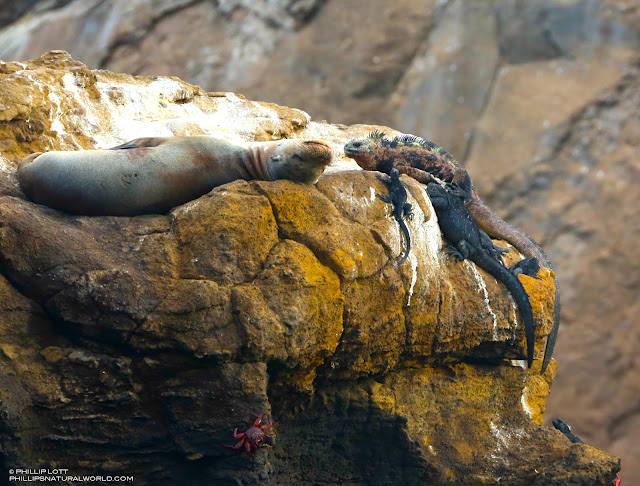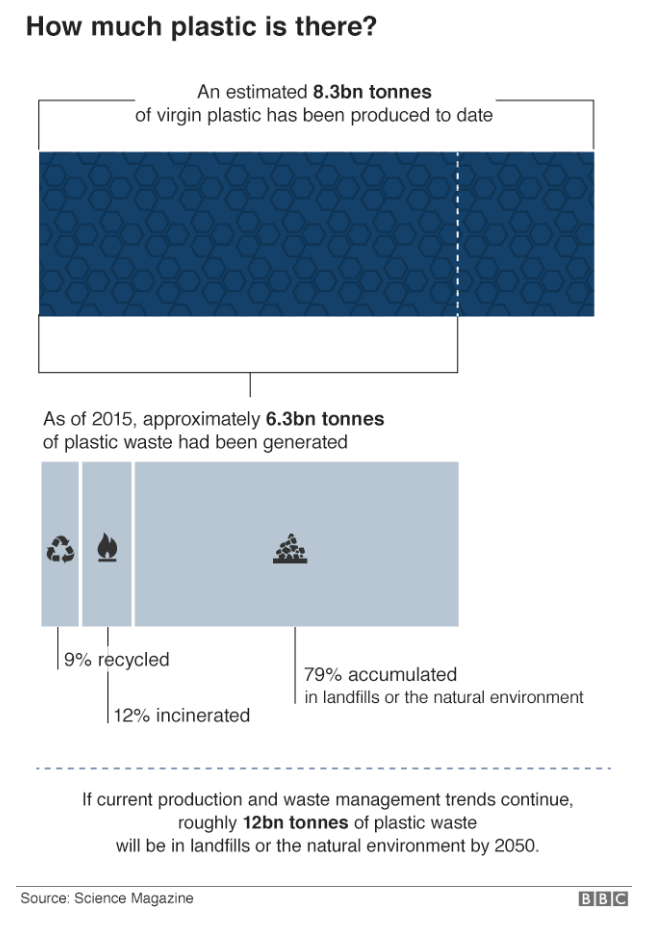"This is a planetary crisis. . . we are ruining the ecosystem of the oceans," UN oceans chief Lisa Svensson says.
But how does this happen, where is most at risk and what damage does this plastic actually do?
Why is plastic problematic?
Plastic as we know it has only really existed for the last 60-70 years, but in that time it has transformed everything from clothing, cooking and catering, to product design, engineering and retailing.
One of the great advantages of many types of plastic is that they're designed to last - for a very long time.
And nearly all the plastic ever created still exists in some form today.
![]()
Follow Phillip
from Galápagos Islands
on instagram


In July a paper published in the journal Science Advances by industrial ecologist Dr Roland Geyer, from the University of California in Santa Barbara, and colleagues, calculated the total volume of all plastic ever produced at 8.3 billion tons.
Of this, some 6.3 billion tons is now waste - and 79% of that is in landfill or the natural environment.
Boycott Coca Cola:
Most discarded plastic bottles are produced by Coca ColaBoycott Coca Cola:
This vast amount of waste has been driven by modern life, where plastic is used for many throwaway or "single use" items, from drinks bottles and diapers to cutlery and q-tips.
Four billion plastic bottles...
Drinks bottles are one the most common types of plastic waste. Some 480 billion plastic bottles were sold globally in 2016 - that's a million bottles per minute.
Of these, 110 billion were made by drinks giant Coca Cola.
Some countries are considering moves to reduce consumption.
Proposals in the UK include deposit-return schemes, and the improvement of free-drinking water supplies in major cities, including London.
So how much plastic waste ends up in the sea?
It's likely that about 10 million tons of plastic currently ends up in the oceans each year.
In 2010 scientists from the National Center for Ecological Analysis and Synthesis and the University of Georgia in Athens estimated the figure as 8 million tons, and forecast that to rise to 9.1 million tons by 2015.
The same study, published in the journal Science in 2015, surveyed 192 coastal countries contributing to ocean plastic waste, and found that Asian nations were 13 of the 20 biggest contributors.
China was top of the list of countries mismanaging plastic waste, but the US also featured in the top 20 and contributed a higher rate of waste per person.
Plastic waste accumulates in areas of the ocean where winds create swirling circular currents, known as gyres, which suck in any floating debris.
There are five gyres around the globe, but the best known is probably the North Pacific gyre.
It is estimated debris takes about six years to reach the centre of the North Pacific gyre from the coast of the US, and about a year from Japan.
All five gyres have higher concentrations of plastic rubbish than other parts of the oceans.
They are made up of tiny fragments of plastic, which appear to hang suspended below the surface - a phenomenon that has led it to being described as plastic soup.
And the hard-wearing qualities of most plastics means that some items can take hundreds of years to biodegrade.
However, there are moves to clean up the North Pacific gyre. An operation led by a non-profit organization Ocean Cleanup is due to begin in 2018.
How bad are things in the UK?
The Marine Conservation Society found 718 pieces of litter for every 100 meter stretch of beach surveyed during their recent Great British Beach Clean Up. That was a 10% increase on last year.
Rubbish from food and drink constituted at least 20% of all litter collected,the MCS reported.
The origin of a lot of the litter is difficult to trace, but the public contributes about 30%. "Sewage-related debris,"or items flushed down toilets that should have been put in the trash, amounted to some 8.5%.
Why is plastic so harmful to marine life?
For sea birds and larger marine creatures like turtles, dolphins and seals, the danger comes from being entangled in plastic bags and other debris, or mistaking plastic for food.
Turtles cannot distinguish between plastic bags and jellyfish, which can be part of their diet. Plastic bags, once consumed, cause internal blockages and usually result in death.
Larger pieces of plastic can also damage the digestive systems of sea birds and whales, and can be potentially fatal.
Over time, plastic waste slowly degrades and breaks down into tiny micro-fragments which are also causing scientists concern.
A recent survey by Plymouth University found that plastic was found in a third of UK-caught fish, including cod, haddock, mackerel and shellfish.
This can result in malnutrition or starvation for the fish, and lead to plastic ingestion in humans too.
The effect on humans of eating fish containing plastic is still largely unknown.
But in 2016 the European Food Safety Authority warned of an increased risk to human health and food safety "given the potential for micro-plastic pollution in edible tissues of commercial fish."
We've Read
This should have been a triumphant week for Justin Timberlake.
His fifth album Man of the Woods - billed as a return to the singer's Tennessee roots - came out on Friday, and he played the Super Bowl Half Time Show two days later, making him the only artist to grace the coveted stage three times.
But both the record and his performance have been savaged by critics. Here's a sample of the comments.
On Man of the Woods:
"We are now approaching the 12th year of the national delusion that Justin Timberlake remains an essential pop star." [New York Times]
"There's no refuge from the lyrics, which in many places engender the same mix of emotions you'd confront upon walking in on your parents having sex." [Pitchfork]
Aesthetically and ethically, Timberlake's magic didn't take. It seemed like he'd cast the wrong spell, making himself invisible within swarms of dancers." [NPR]
"He was a man in the weeds, scrambling through his archives to find any moment that might connect with an audience that, in substantial part, hasn't lived with his music." [Time Magazine]
"The show is almost over. And then it is. And a feeling of togetherness washes over us, a feeling of certainty that we all just witnessed something unambiguously underwhelming." [Washington Post]
What Went Wrong
What Went Wrong
Timberlake must be wondering what went wrong. Because, truth be told, there's nothing egregiously bad about either Man of the Woods or his Super Bowl performance. They're just... disappointing.
The backlash feels bigger than a commentary on his music. There's a mockery and a cruelty that feels personal - as though people had a lingering resentment towards the star, and they've suddenly been given licence to express it.
For some, it goes back to his relationship with Britney Spears. After they broke up, he made music and videos that traded on their story and told several interviewers he'd taken her virginity - a personal detail that wasn't his to share.
For others, it's about his failure to support Janet Jackson after exposing her breast to millions of TV viewers at the 2004 Super Bowl.
Timberlake's half-hearted acknowledgement of that moment at this year's show did not go unnoticed.
"He chose to perform the song Rock Your Body, during which the famous wardrobe malfunction took place, and yet he didn't mention Janet: He didn't shout her out, and he stopped the song right before the line during which he ripped off her costume,"pop critic Ann Powers told NPR.
"It was almost like he was trying to erase what had happened in the past, but that is just not flying in 2018."
"The Super Bowl performance invited people to reflect on the time Justin threw Janet Jackson under a bus, and what that said about race and gender," agrees Peter Robinson, editor of Popjustice.
Timberlake has also been criticised for his fumbled response to the #TimesUp movement.
He starred in Woody Allen's latest film, Wonder Wheel, but appeared not to consider the moral implications of working with the director, who has been accused of sexual abuse by his adopted daughter.
"I chose to not get into it,"he told The Hollywood Reporter. "I really don't dive into any of that stuff with anybody."
"He's spectacularly misjudged this comeback in a lot of different ways," says Laura Snapes, deputy music editor at The Guardian.
"It's a terrible mess of things to do with racial signifiers and gender signifiers.
"At this point in time, we're expecting pop stars to be spokespeople on a certain level, and he's definitely not living up to that."
Last month, in an article for New York Magazine, the critic Molly Fischer dubbed this phenomenon "Pop Culture's Great Awokening".
It has become "impossible to discuss contemporary pop culture" without weighing such concerns as "racial, cultural, sexual, and gender identities", she argued. And what's more, we expect our artists to reflect that conversation.
It's a theme that derailed Katy Perry's album campaign last year - after making a gesture towards political activism on the single Chained To The Rhythm, she retreated to familiar territory with Bon Appetit, a cartoonish ode to oral sex.
"It's interesting how Katy was demolished for trying to be woke and Justin's being criticised for not trying at all," says Peter Robinson.
"In each of those cases, there's been a pack mentality in the media - once they sense blood, it's open season, and so for every pertinent article there end up being 20 that just exist for clicks, or as an exercise in young writers demolishing a previous generation's pop icons.










